How an organisation culture, power and politics influence individual and team performance
VerifiedAdded on 2021/02/20
|16
|4904
|448
AI Summary
1 Organisational Behaviour INTRODUCTION 3 TASK 13 P1 Analyse how an organisation culture, politics and power influence an individual and team 3 M1 Critically analyse how culture, power and politics of an organisation can influence an individual team behaviour and team performance 5 TASK 26 P2 Explain how content and process theories of motivation can help to achieve best out of its employees 6 M2 Critically evaluates how to influences the behaviour of others through an application of the behavioural and motivational theories8 D
Contribute Materials
Your contribution can guide someone’s learning journey. Share your
documents today.
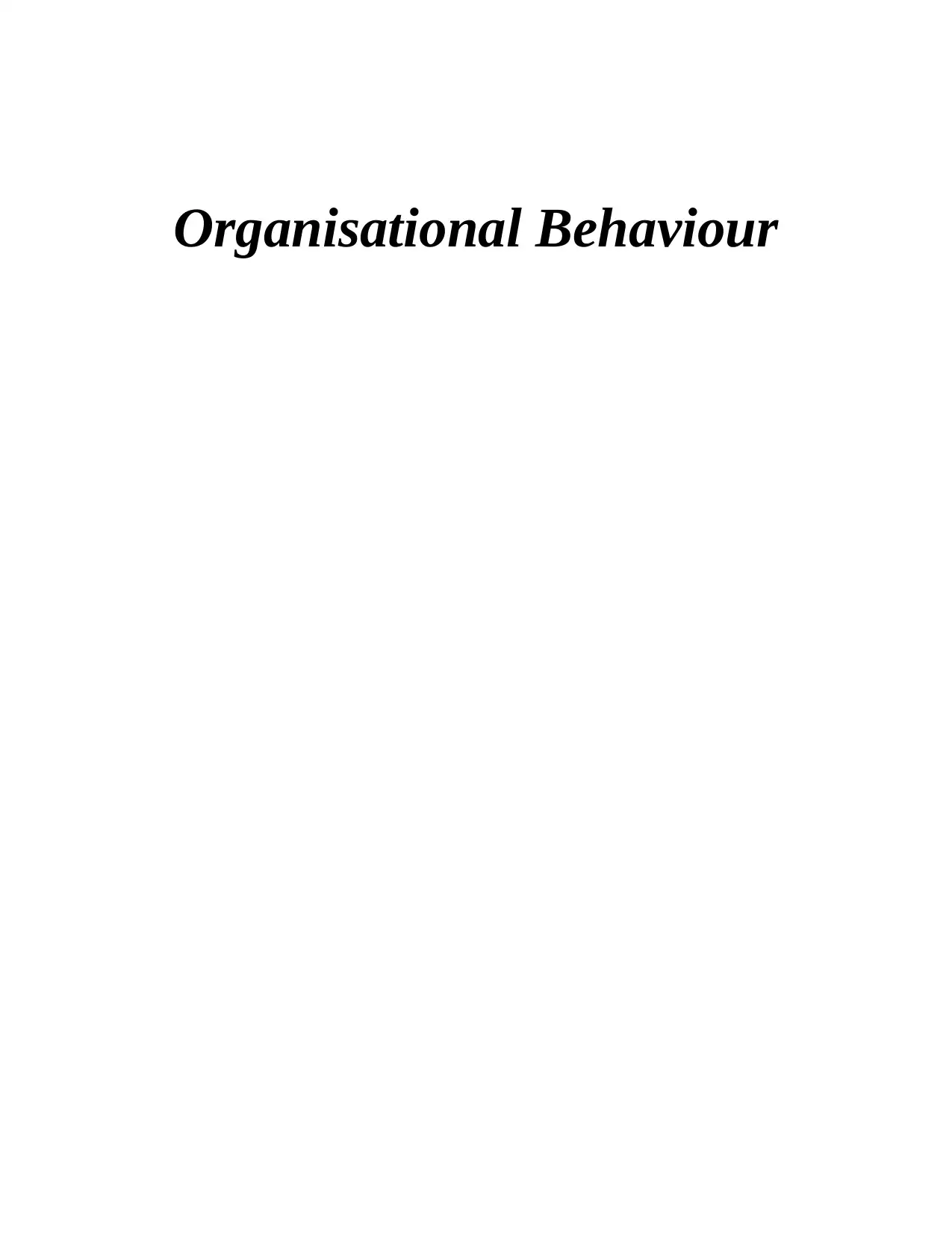
Organisational Behaviour
Secure Best Marks with AI Grader
Need help grading? Try our AI Grader for instant feedback on your assignments.
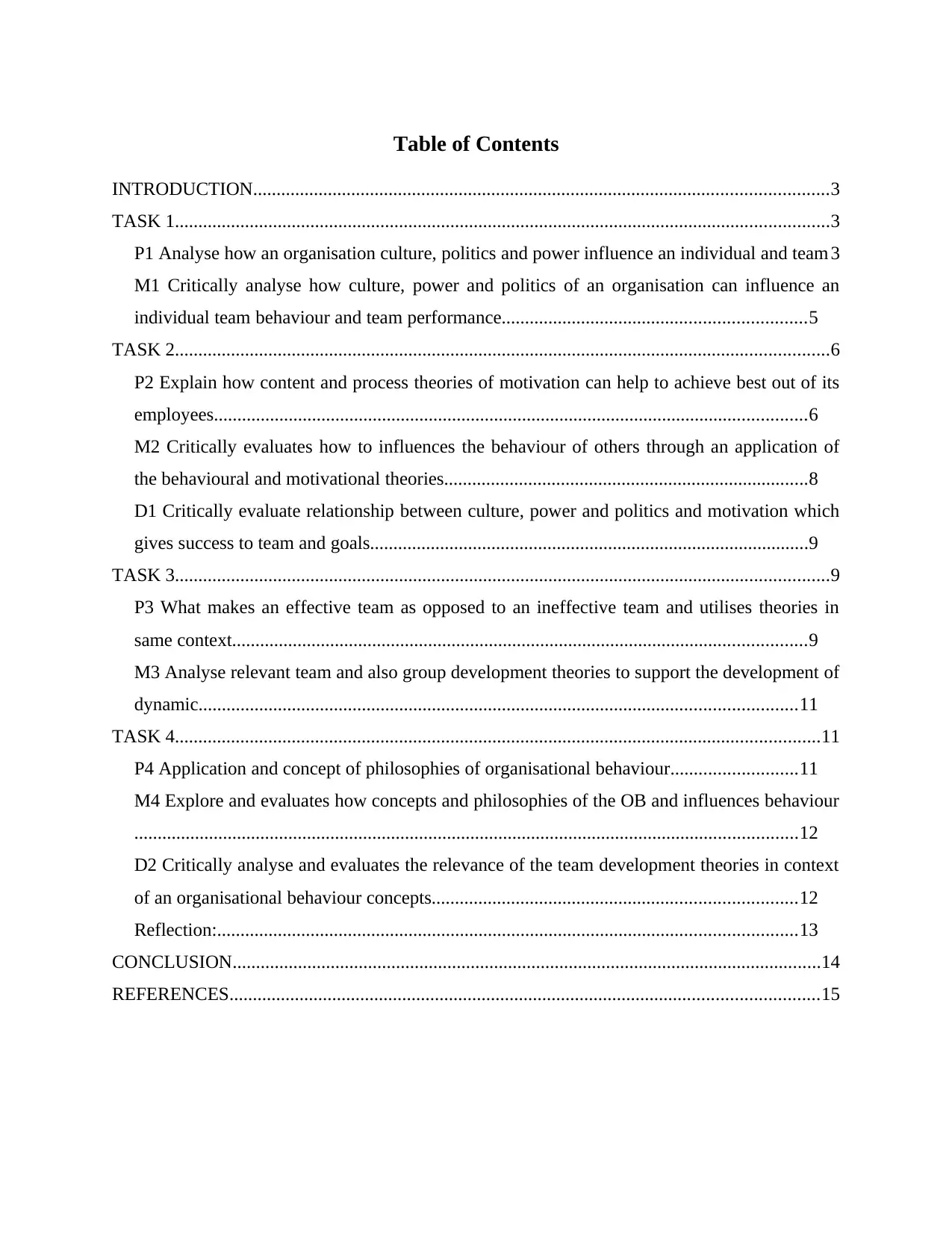
Table of Contents
INTRODUCTION...........................................................................................................................3
TASK 1............................................................................................................................................3
P1 Analyse how an organisation culture, politics and power influence an individual and team 3
M1 Critically analyse how culture, power and politics of an organisation can influence an
individual team behaviour and team performance.................................................................5
TASK 2............................................................................................................................................6
P2 Explain how content and process theories of motivation can help to achieve best out of its
employees...............................................................................................................................6
M2 Critically evaluates how to influences the behaviour of others through an application of
the behavioural and motivational theories..............................................................................8
D1 Critically evaluate relationship between culture, power and politics and motivation which
gives success to team and goals..............................................................................................9
TASK 3............................................................................................................................................9
P3 What makes an effective team as opposed to an ineffective team and utilises theories in
same context...........................................................................................................................9
M3 Analyse relevant team and also group development theories to support the development of
dynamic................................................................................................................................11
TASK 4..........................................................................................................................................11
P4 Application and concept of philosophies of organisational behaviour...........................11
M4 Explore and evaluates how concepts and philosophies of the OB and influences behaviour
..............................................................................................................................................12
D2 Critically analyse and evaluates the relevance of the team development theories in context
of an organisational behaviour concepts..............................................................................12
Reflection:............................................................................................................................13
CONCLUSION..............................................................................................................................14
REFERENCES..............................................................................................................................15
INTRODUCTION...........................................................................................................................3
TASK 1............................................................................................................................................3
P1 Analyse how an organisation culture, politics and power influence an individual and team 3
M1 Critically analyse how culture, power and politics of an organisation can influence an
individual team behaviour and team performance.................................................................5
TASK 2............................................................................................................................................6
P2 Explain how content and process theories of motivation can help to achieve best out of its
employees...............................................................................................................................6
M2 Critically evaluates how to influences the behaviour of others through an application of
the behavioural and motivational theories..............................................................................8
D1 Critically evaluate relationship between culture, power and politics and motivation which
gives success to team and goals..............................................................................................9
TASK 3............................................................................................................................................9
P3 What makes an effective team as opposed to an ineffective team and utilises theories in
same context...........................................................................................................................9
M3 Analyse relevant team and also group development theories to support the development of
dynamic................................................................................................................................11
TASK 4..........................................................................................................................................11
P4 Application and concept of philosophies of organisational behaviour...........................11
M4 Explore and evaluates how concepts and philosophies of the OB and influences behaviour
..............................................................................................................................................12
D2 Critically analyse and evaluates the relevance of the team development theories in context
of an organisational behaviour concepts..............................................................................12
Reflection:............................................................................................................................13
CONCLUSION..............................................................................................................................14
REFERENCES..............................................................................................................................15
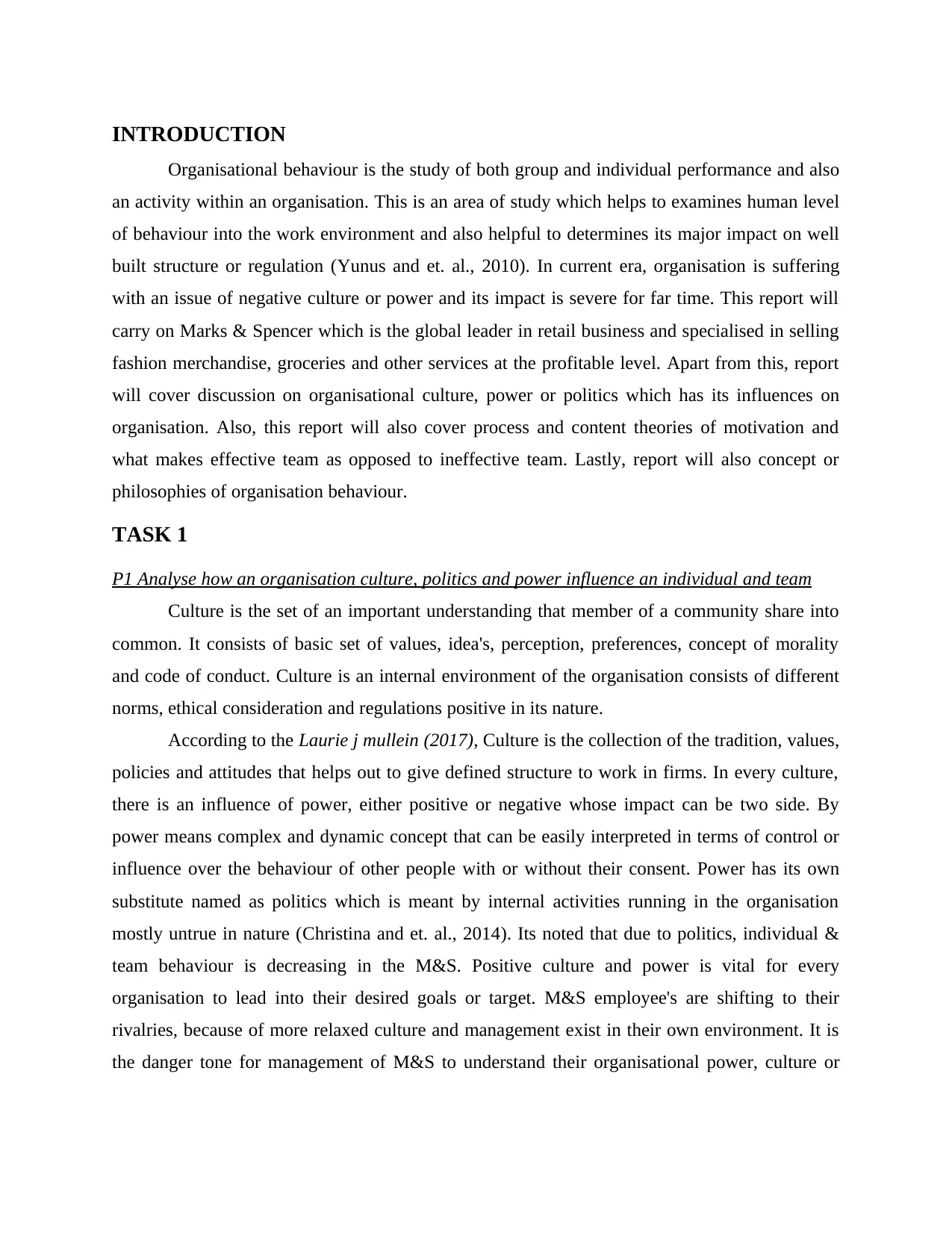
INTRODUCTION
Organisational behaviour is the study of both group and individual performance and also
an activity within an organisation. This is an area of study which helps to examines human level
of behaviour into the work environment and also helpful to determines its major impact on well
built structure or regulation (Yunus and et. al., 2010). In current era, organisation is suffering
with an issue of negative culture or power and its impact is severe for far time. This report will
carry on Marks & Spencer which is the global leader in retail business and specialised in selling
fashion merchandise, groceries and other services at the profitable level. Apart from this, report
will cover discussion on organisational culture, power or politics which has its influences on
organisation. Also, this report will also cover process and content theories of motivation and
what makes effective team as opposed to ineffective team. Lastly, report will also concept or
philosophies of organisation behaviour.
TASK 1
P1 Analyse how an organisation culture, politics and power influence an individual and team
Culture is the set of an important understanding that member of a community share into
common. It consists of basic set of values, idea's, perception, preferences, concept of morality
and code of conduct. Culture is an internal environment of the organisation consists of different
norms, ethical consideration and regulations positive in its nature.
According to the Laurie j mullein (2017), Culture is the collection of the tradition, values,
policies and attitudes that helps out to give defined structure to work in firms. In every culture,
there is an influence of power, either positive or negative whose impact can be two side. By
power means complex and dynamic concept that can be easily interpreted in terms of control or
influence over the behaviour of other people with or without their consent. Power has its own
substitute named as politics which is meant by internal activities running in the organisation
mostly untrue in nature (Christina and et. al., 2014). Its noted that due to politics, individual &
team behaviour is decreasing in the M&S. Positive culture and power is vital for every
organisation to lead into their desired goals or target. M&S employee's are shifting to their
rivalries, because of more relaxed culture and management exist in their own environment. It is
the danger tone for management of M&S to understand their organisational power, culture or
Organisational behaviour is the study of both group and individual performance and also
an activity within an organisation. This is an area of study which helps to examines human level
of behaviour into the work environment and also helpful to determines its major impact on well
built structure or regulation (Yunus and et. al., 2010). In current era, organisation is suffering
with an issue of negative culture or power and its impact is severe for far time. This report will
carry on Marks & Spencer which is the global leader in retail business and specialised in selling
fashion merchandise, groceries and other services at the profitable level. Apart from this, report
will cover discussion on organisational culture, power or politics which has its influences on
organisation. Also, this report will also cover process and content theories of motivation and
what makes effective team as opposed to ineffective team. Lastly, report will also concept or
philosophies of organisation behaviour.
TASK 1
P1 Analyse how an organisation culture, politics and power influence an individual and team
Culture is the set of an important understanding that member of a community share into
common. It consists of basic set of values, idea's, perception, preferences, concept of morality
and code of conduct. Culture is an internal environment of the organisation consists of different
norms, ethical consideration and regulations positive in its nature.
According to the Laurie j mullein (2017), Culture is the collection of the tradition, values,
policies and attitudes that helps out to give defined structure to work in firms. In every culture,
there is an influence of power, either positive or negative whose impact can be two side. By
power means complex and dynamic concept that can be easily interpreted in terms of control or
influence over the behaviour of other people with or without their consent. Power has its own
substitute named as politics which is meant by internal activities running in the organisation
mostly untrue in nature (Christina and et. al., 2014). Its noted that due to politics, individual &
team behaviour is decreasing in the M&S. Positive culture and power is vital for every
organisation to lead into their desired goals or target. M&S employee's are shifting to their
rivalries, because of more relaxed culture and management exist in their own environment. It is
the danger tone for management of M&S to understand their organisational power, culture or
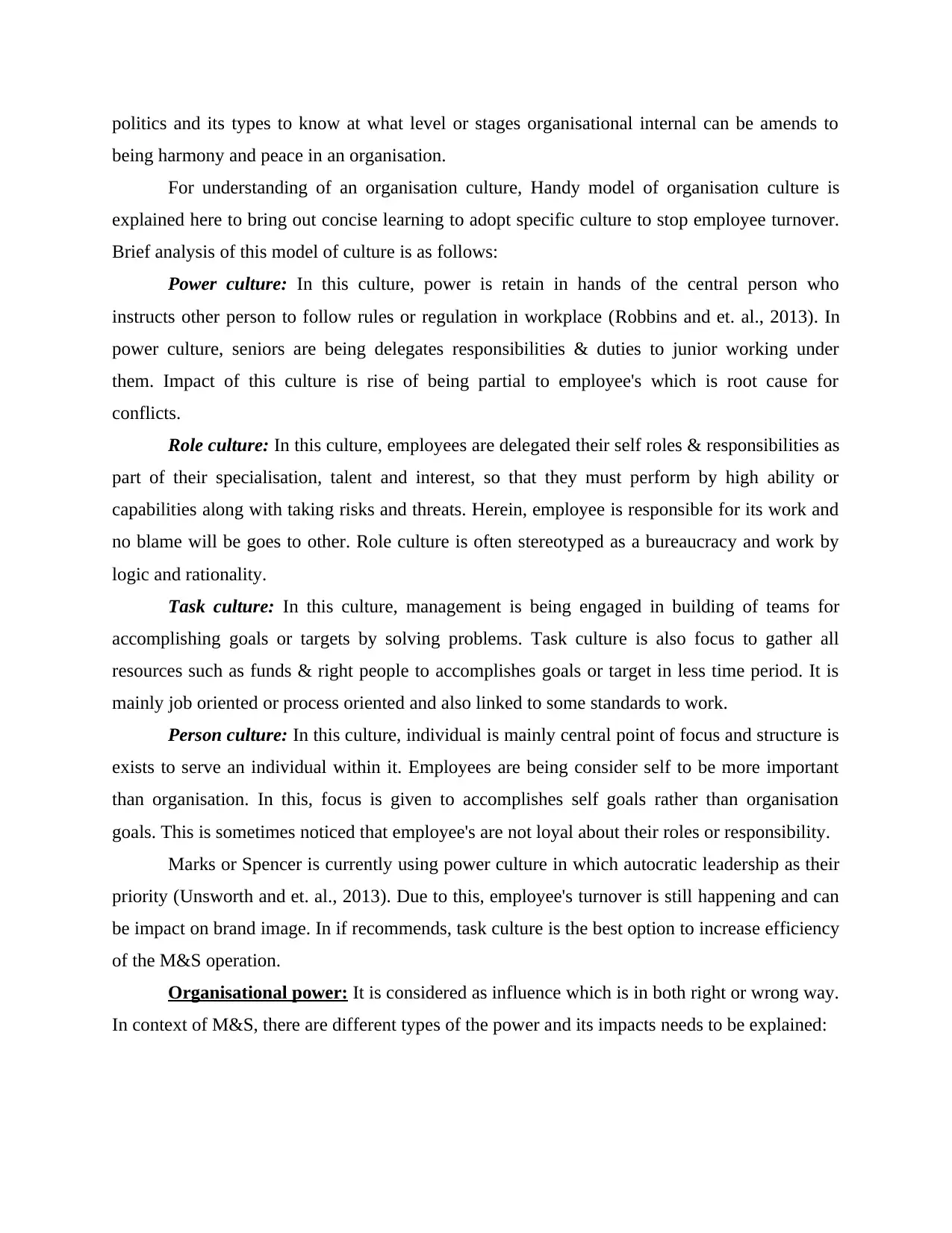
politics and its types to know at what level or stages organisational internal can be amends to
being harmony and peace in an organisation.
For understanding of an organisation culture, Handy model of organisation culture is
explained here to bring out concise learning to adopt specific culture to stop employee turnover.
Brief analysis of this model of culture is as follows:
Power culture: In this culture, power is retain in hands of the central person who
instructs other person to follow rules or regulation in workplace (Robbins and et. al., 2013). In
power culture, seniors are being delegates responsibilities & duties to junior working under
them. Impact of this culture is rise of being partial to employee's which is root cause for
conflicts.
Role culture: In this culture, employees are delegated their self roles & responsibilities as
part of their specialisation, talent and interest, so that they must perform by high ability or
capabilities along with taking risks and threats. Herein, employee is responsible for its work and
no blame will be goes to other. Role culture is often stereotyped as a bureaucracy and work by
logic and rationality.
Task culture: In this culture, management is being engaged in building of teams for
accomplishing goals or targets by solving problems. Task culture is also focus to gather all
resources such as funds & right people to accomplishes goals or target in less time period. It is
mainly job oriented or process oriented and also linked to some standards to work.
Person culture: In this culture, individual is mainly central point of focus and structure is
exists to serve an individual within it. Employees are being consider self to be more important
than organisation. In this, focus is given to accomplishes self goals rather than organisation
goals. This is sometimes noticed that employee's are not loyal about their roles or responsibility.
Marks or Spencer is currently using power culture in which autocratic leadership as their
priority (Unsworth and et. al., 2013). Due to this, employee's turnover is still happening and can
be impact on brand image. In if recommends, task culture is the best option to increase efficiency
of the M&S operation.
Organisational power: It is considered as influence which is in both right or wrong way.
In context of M&S, there are different types of the power and its impacts needs to be explained:
being harmony and peace in an organisation.
For understanding of an organisation culture, Handy model of organisation culture is
explained here to bring out concise learning to adopt specific culture to stop employee turnover.
Brief analysis of this model of culture is as follows:
Power culture: In this culture, power is retain in hands of the central person who
instructs other person to follow rules or regulation in workplace (Robbins and et. al., 2013). In
power culture, seniors are being delegates responsibilities & duties to junior working under
them. Impact of this culture is rise of being partial to employee's which is root cause for
conflicts.
Role culture: In this culture, employees are delegated their self roles & responsibilities as
part of their specialisation, talent and interest, so that they must perform by high ability or
capabilities along with taking risks and threats. Herein, employee is responsible for its work and
no blame will be goes to other. Role culture is often stereotyped as a bureaucracy and work by
logic and rationality.
Task culture: In this culture, management is being engaged in building of teams for
accomplishing goals or targets by solving problems. Task culture is also focus to gather all
resources such as funds & right people to accomplishes goals or target in less time period. It is
mainly job oriented or process oriented and also linked to some standards to work.
Person culture: In this culture, individual is mainly central point of focus and structure is
exists to serve an individual within it. Employees are being consider self to be more important
than organisation. In this, focus is given to accomplishes self goals rather than organisation
goals. This is sometimes noticed that employee's are not loyal about their roles or responsibility.
Marks or Spencer is currently using power culture in which autocratic leadership as their
priority (Unsworth and et. al., 2013). Due to this, employee's turnover is still happening and can
be impact on brand image. In if recommends, task culture is the best option to increase efficiency
of the M&S operation.
Organisational power: It is considered as influence which is in both right or wrong way.
In context of M&S, there are different types of the power and its impacts needs to be explained:
Secure Best Marks with AI Grader
Need help grading? Try our AI Grader for instant feedback on your assignments.
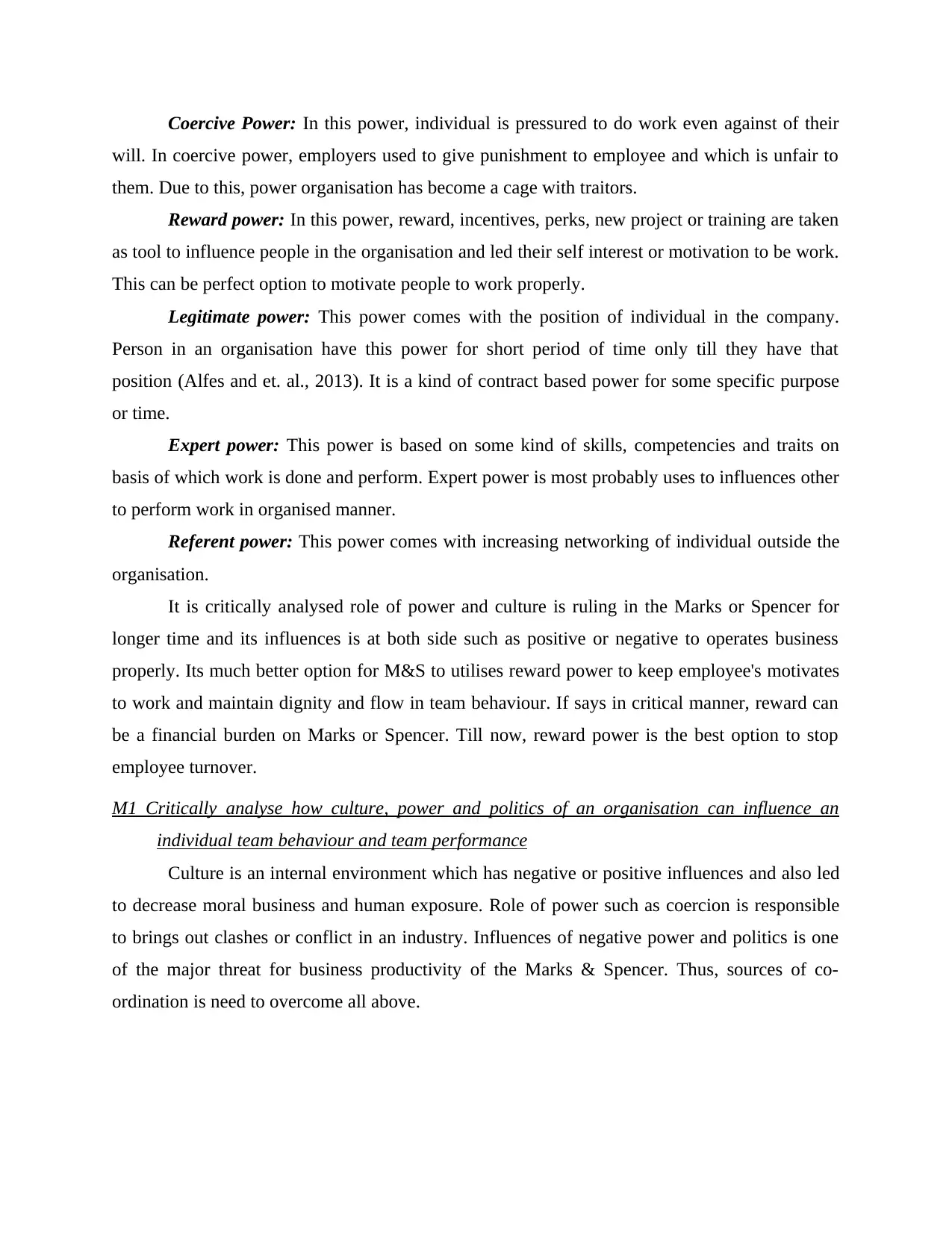
Coercive Power: In this power, individual is pressured to do work even against of their
will. In coercive power, employers used to give punishment to employee and which is unfair to
them. Due to this, power organisation has become a cage with traitors.
Reward power: In this power, reward, incentives, perks, new project or training are taken
as tool to influence people in the organisation and led their self interest or motivation to be work.
This can be perfect option to motivate people to work properly.
Legitimate power: This power comes with the position of individual in the company.
Person in an organisation have this power for short period of time only till they have that
position (Alfes and et. al., 2013). It is a kind of contract based power for some specific purpose
or time.
Expert power: This power is based on some kind of skills, competencies and traits on
basis of which work is done and perform. Expert power is most probably uses to influences other
to perform work in organised manner.
Referent power: This power comes with increasing networking of individual outside the
organisation.
It is critically analysed role of power and culture is ruling in the Marks or Spencer for
longer time and its influences is at both side such as positive or negative to operates business
properly. Its much better option for M&S to utilises reward power to keep employee's motivates
to work and maintain dignity and flow in team behaviour. If says in critical manner, reward can
be a financial burden on Marks or Spencer. Till now, reward power is the best option to stop
employee turnover.
M1 Critically analyse how culture, power and politics of an organisation can influence an
individual team behaviour and team performance
Culture is an internal environment which has negative or positive influences and also led
to decrease moral business and human exposure. Role of power such as coercion is responsible
to brings out clashes or conflict in an industry. Influences of negative power and politics is one
of the major threat for business productivity of the Marks & Spencer. Thus, sources of co-
ordination is need to overcome all above.
will. In coercive power, employers used to give punishment to employee and which is unfair to
them. Due to this, power organisation has become a cage with traitors.
Reward power: In this power, reward, incentives, perks, new project or training are taken
as tool to influence people in the organisation and led their self interest or motivation to be work.
This can be perfect option to motivate people to work properly.
Legitimate power: This power comes with the position of individual in the company.
Person in an organisation have this power for short period of time only till they have that
position (Alfes and et. al., 2013). It is a kind of contract based power for some specific purpose
or time.
Expert power: This power is based on some kind of skills, competencies and traits on
basis of which work is done and perform. Expert power is most probably uses to influences other
to perform work in organised manner.
Referent power: This power comes with increasing networking of individual outside the
organisation.
It is critically analysed role of power and culture is ruling in the Marks or Spencer for
longer time and its influences is at both side such as positive or negative to operates business
properly. Its much better option for M&S to utilises reward power to keep employee's motivates
to work and maintain dignity and flow in team behaviour. If says in critical manner, reward can
be a financial burden on Marks or Spencer. Till now, reward power is the best option to stop
employee turnover.
M1 Critically analyse how culture, power and politics of an organisation can influence an
individual team behaviour and team performance
Culture is an internal environment which has negative or positive influences and also led
to decrease moral business and human exposure. Role of power such as coercion is responsible
to brings out clashes or conflict in an industry. Influences of negative power and politics is one
of the major threat for business productivity of the Marks & Spencer. Thus, sources of co-
ordination is need to overcome all above.
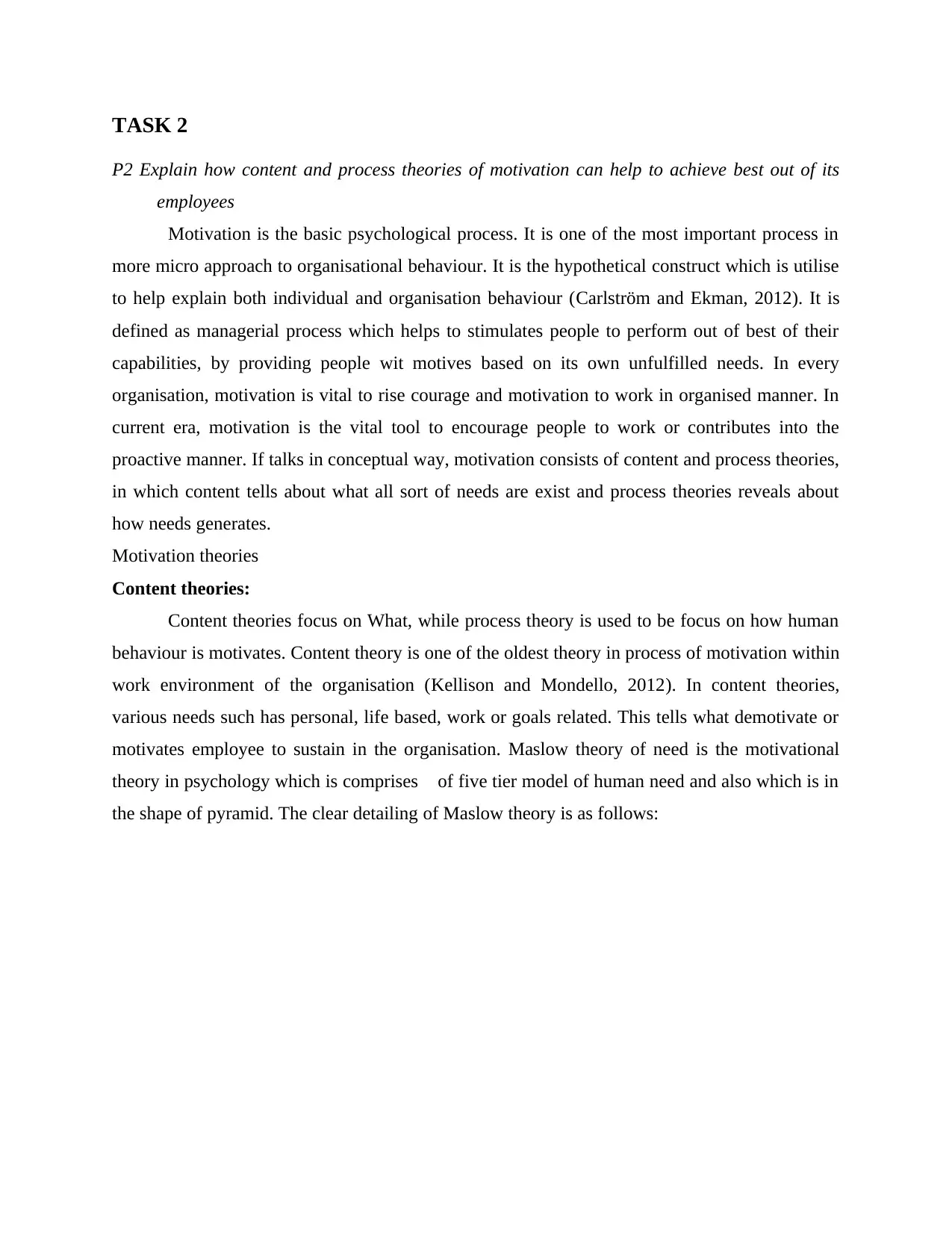
TASK 2
P2 Explain how content and process theories of motivation can help to achieve best out of its
employees
Motivation is the basic psychological process. It is one of the most important process in
more micro approach to organisational behaviour. It is the hypothetical construct which is utilise
to help explain both individual and organisation behaviour (Carlström and Ekman, 2012). It is
defined as managerial process which helps to stimulates people to perform out of best of their
capabilities, by providing people wit motives based on its own unfulfilled needs. In every
organisation, motivation is vital to rise courage and motivation to work in organised manner. In
current era, motivation is the vital tool to encourage people to work or contributes into the
proactive manner. If talks in conceptual way, motivation consists of content and process theories,
in which content tells about what all sort of needs are exist and process theories reveals about
how needs generates.
Motivation theories
Content theories:
Content theories focus on What, while process theory is used to be focus on how human
behaviour is motivates. Content theory is one of the oldest theory in process of motivation within
work environment of the organisation (Kellison and Mondello, 2012). In content theories,
various needs such has personal, life based, work or goals related. This tells what demotivate or
motivates employee to sustain in the organisation. Maslow theory of need is the motivational
theory in psychology which is comprises of five tier model of human need and also which is in
the shape of pyramid. The clear detailing of Maslow theory is as follows:
P2 Explain how content and process theories of motivation can help to achieve best out of its
employees
Motivation is the basic psychological process. It is one of the most important process in
more micro approach to organisational behaviour. It is the hypothetical construct which is utilise
to help explain both individual and organisation behaviour (Carlström and Ekman, 2012). It is
defined as managerial process which helps to stimulates people to perform out of best of their
capabilities, by providing people wit motives based on its own unfulfilled needs. In every
organisation, motivation is vital to rise courage and motivation to work in organised manner. In
current era, motivation is the vital tool to encourage people to work or contributes into the
proactive manner. If talks in conceptual way, motivation consists of content and process theories,
in which content tells about what all sort of needs are exist and process theories reveals about
how needs generates.
Motivation theories
Content theories:
Content theories focus on What, while process theory is used to be focus on how human
behaviour is motivates. Content theory is one of the oldest theory in process of motivation within
work environment of the organisation (Kellison and Mondello, 2012). In content theories,
various needs such has personal, life based, work or goals related. This tells what demotivate or
motivates employee to sustain in the organisation. Maslow theory of need is the motivational
theory in psychology which is comprises of five tier model of human need and also which is in
the shape of pyramid. The clear detailing of Maslow theory is as follows:
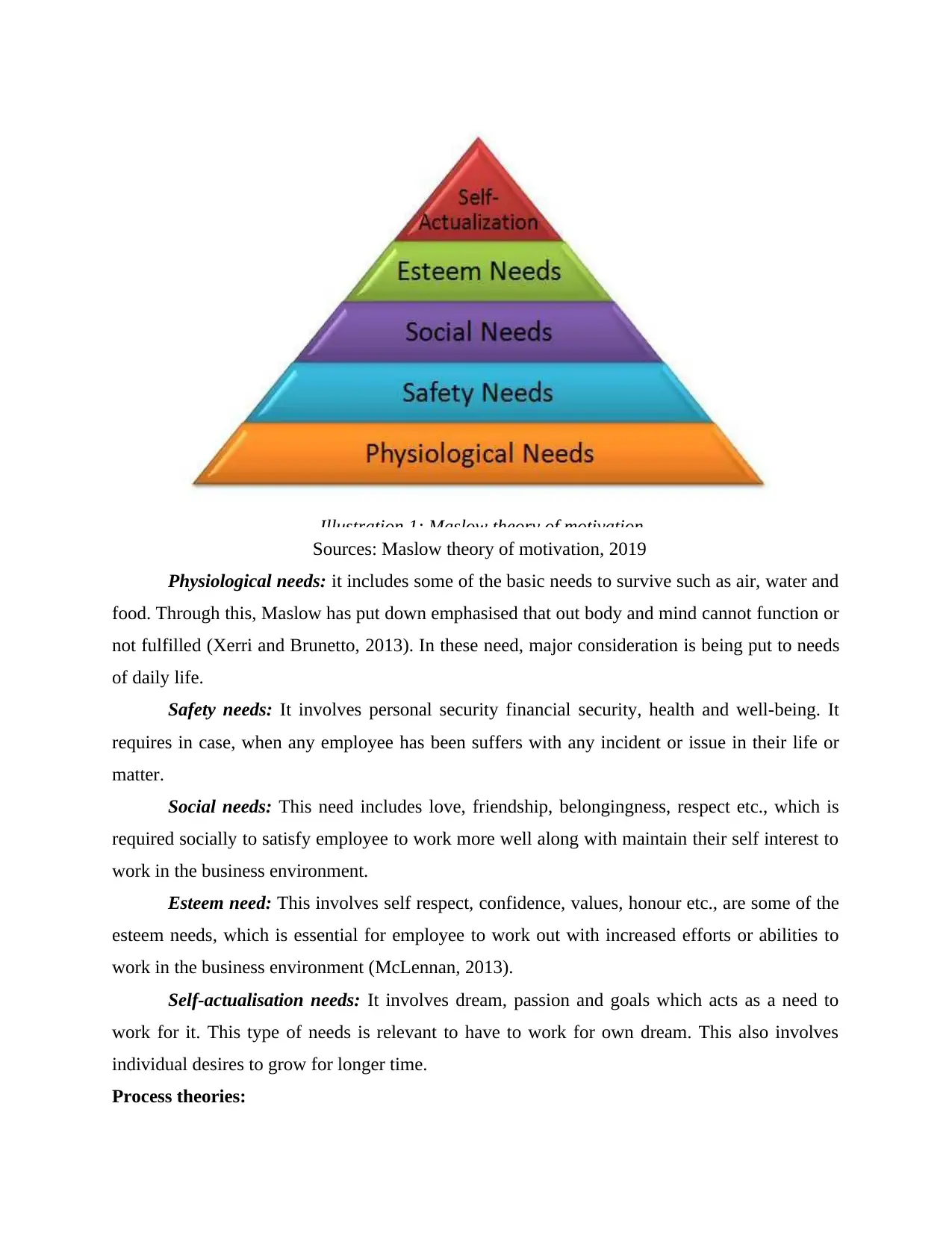
Sources: Maslow theory of motivation, 2019
Physiological needs: it includes some of the basic needs to survive such as air, water and
food. Through this, Maslow has put down emphasised that out body and mind cannot function or
not fulfilled (Xerri and Brunetto, 2013). In these need, major consideration is being put to needs
of daily life.
Safety needs: It involves personal security financial security, health and well-being. It
requires in case, when any employee has been suffers with any incident or issue in their life or
matter.
Social needs: This need includes love, friendship, belongingness, respect etc., which is
required socially to satisfy employee to work more well along with maintain their self interest to
work in the business environment.
Esteem need: This involves self respect, confidence, values, honour etc., are some of the
esteem needs, which is essential for employee to work out with increased efforts or abilities to
work in the business environment (McLennan, 2013).
Self-actualisation needs: It involves dream, passion and goals which acts as a need to
work for it. This type of needs is relevant to have to work for own dream. This also involves
individual desires to grow for longer time.
Process theories:
Illustration 1: Maslow theory of motivation
Physiological needs: it includes some of the basic needs to survive such as air, water and
food. Through this, Maslow has put down emphasised that out body and mind cannot function or
not fulfilled (Xerri and Brunetto, 2013). In these need, major consideration is being put to needs
of daily life.
Safety needs: It involves personal security financial security, health and well-being. It
requires in case, when any employee has been suffers with any incident or issue in their life or
matter.
Social needs: This need includes love, friendship, belongingness, respect etc., which is
required socially to satisfy employee to work more well along with maintain their self interest to
work in the business environment.
Esteem need: This involves self respect, confidence, values, honour etc., are some of the
esteem needs, which is essential for employee to work out with increased efforts or abilities to
work in the business environment (McLennan, 2013).
Self-actualisation needs: It involves dream, passion and goals which acts as a need to
work for it. This type of needs is relevant to have to work for own dream. This also involves
individual desires to grow for longer time.
Process theories:
Illustration 1: Maslow theory of motivation
Paraphrase This Document
Need a fresh take? Get an instant paraphrase of this document with our AI Paraphraser
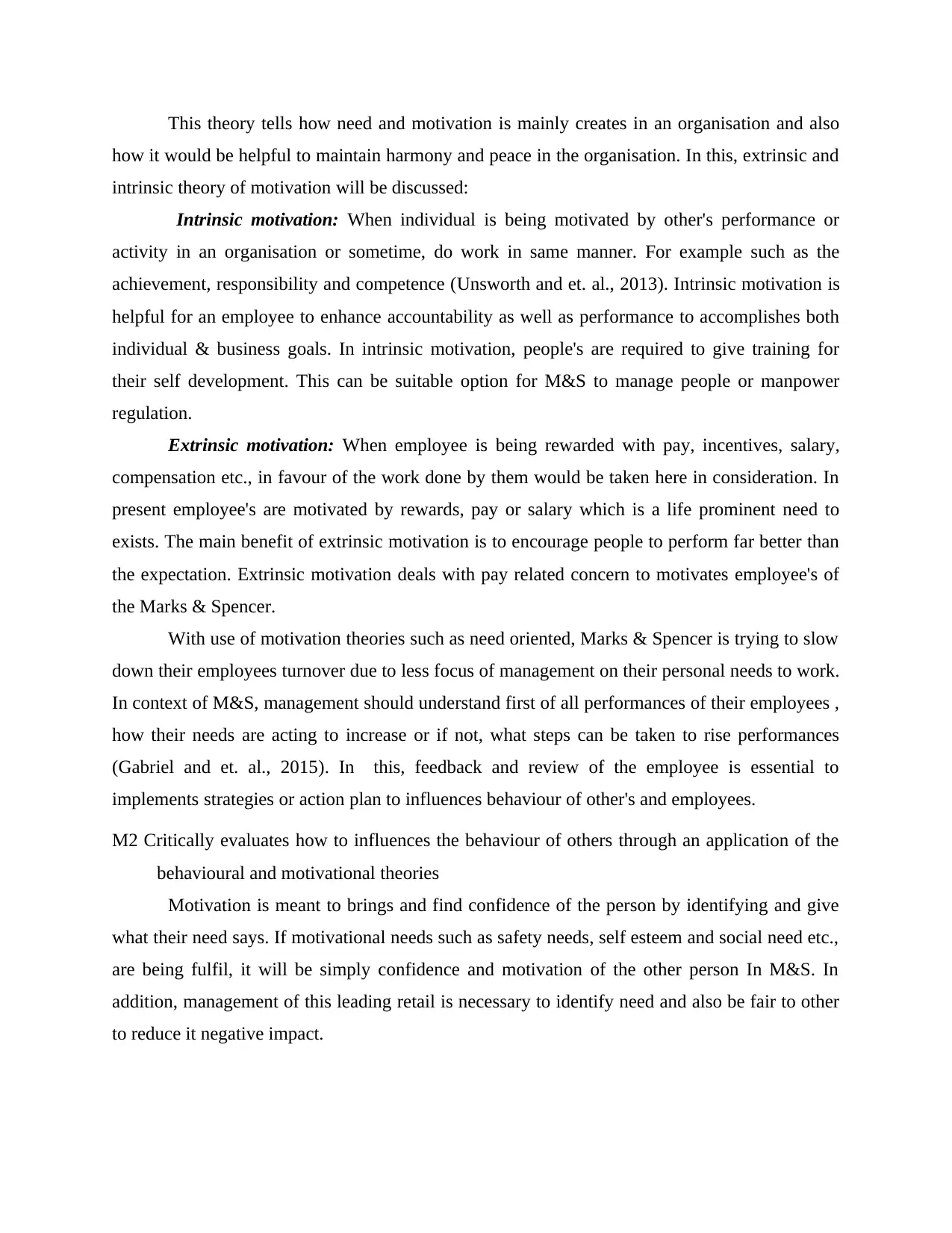
This theory tells how need and motivation is mainly creates in an organisation and also
how it would be helpful to maintain harmony and peace in the organisation. In this, extrinsic and
intrinsic theory of motivation will be discussed:
Intrinsic motivation: When individual is being motivated by other's performance or
activity in an organisation or sometime, do work in same manner. For example such as the
achievement, responsibility and competence (Unsworth and et. al., 2013). Intrinsic motivation is
helpful for an employee to enhance accountability as well as performance to accomplishes both
individual & business goals. In intrinsic motivation, people's are required to give training for
their self development. This can be suitable option for M&S to manage people or manpower
regulation.
Extrinsic motivation: When employee is being rewarded with pay, incentives, salary,
compensation etc., in favour of the work done by them would be taken here in consideration. In
present employee's are motivated by rewards, pay or salary which is a life prominent need to
exists. The main benefit of extrinsic motivation is to encourage people to perform far better than
the expectation. Extrinsic motivation deals with pay related concern to motivates employee's of
the Marks & Spencer.
With use of motivation theories such as need oriented, Marks & Spencer is trying to slow
down their employees turnover due to less focus of management on their personal needs to work.
In context of M&S, management should understand first of all performances of their employees ,
how their needs are acting to increase or if not, what steps can be taken to rise performances
(Gabriel and et. al., 2015). In this, feedback and review of the employee is essential to
implements strategies or action plan to influences behaviour of other's and employees.
M2 Critically evaluates how to influences the behaviour of others through an application of the
behavioural and motivational theories
Motivation is meant to brings and find confidence of the person by identifying and give
what their need says. If motivational needs such as safety needs, self esteem and social need etc.,
are being fulfil, it will be simply confidence and motivation of the other person In M&S. In
addition, management of this leading retail is necessary to identify need and also be fair to other
to reduce it negative impact.
how it would be helpful to maintain harmony and peace in the organisation. In this, extrinsic and
intrinsic theory of motivation will be discussed:
Intrinsic motivation: When individual is being motivated by other's performance or
activity in an organisation or sometime, do work in same manner. For example such as the
achievement, responsibility and competence (Unsworth and et. al., 2013). Intrinsic motivation is
helpful for an employee to enhance accountability as well as performance to accomplishes both
individual & business goals. In intrinsic motivation, people's are required to give training for
their self development. This can be suitable option for M&S to manage people or manpower
regulation.
Extrinsic motivation: When employee is being rewarded with pay, incentives, salary,
compensation etc., in favour of the work done by them would be taken here in consideration. In
present employee's are motivated by rewards, pay or salary which is a life prominent need to
exists. The main benefit of extrinsic motivation is to encourage people to perform far better than
the expectation. Extrinsic motivation deals with pay related concern to motivates employee's of
the Marks & Spencer.
With use of motivation theories such as need oriented, Marks & Spencer is trying to slow
down their employees turnover due to less focus of management on their personal needs to work.
In context of M&S, management should understand first of all performances of their employees ,
how their needs are acting to increase or if not, what steps can be taken to rise performances
(Gabriel and et. al., 2015). In this, feedback and review of the employee is essential to
implements strategies or action plan to influences behaviour of other's and employees.
M2 Critically evaluates how to influences the behaviour of others through an application of the
behavioural and motivational theories
Motivation is meant to brings and find confidence of the person by identifying and give
what their need says. If motivational needs such as safety needs, self esteem and social need etc.,
are being fulfil, it will be simply confidence and motivation of the other person In M&S. In
addition, management of this leading retail is necessary to identify need and also be fair to other
to reduce it negative impact.
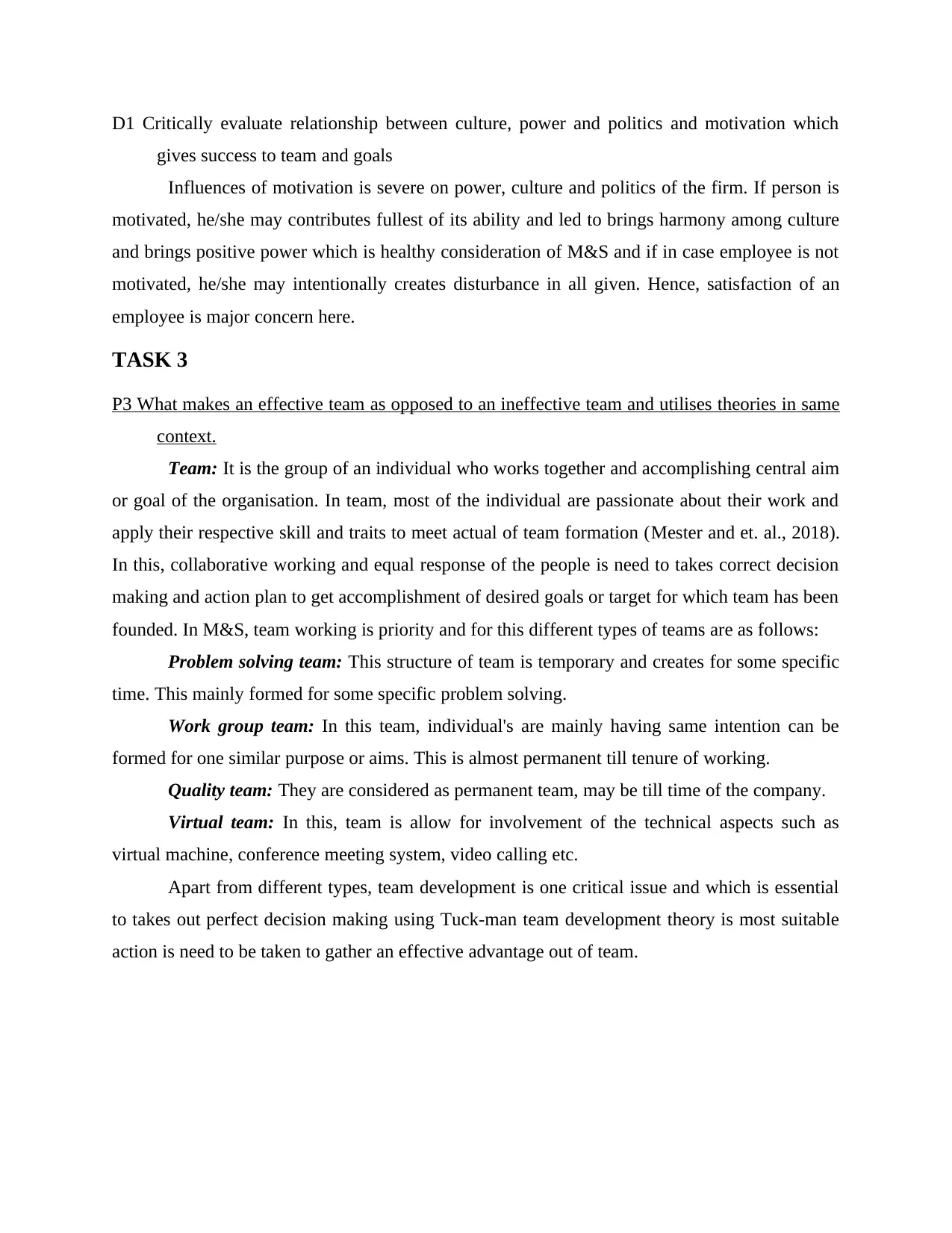
D1 Critically evaluate relationship between culture, power and politics and motivation which
gives success to team and goals
Influences of motivation is severe on power, culture and politics of the firm. If person is
motivated, he/she may contributes fullest of its ability and led to brings harmony among culture
and brings positive power which is healthy consideration of M&S and if in case employee is not
motivated, he/she may intentionally creates disturbance in all given. Hence, satisfaction of an
employee is major concern here.
TASK 3
P3 What makes an effective team as opposed to an ineffective team and utilises theories in same
context.
Team: It is the group of an individual who works together and accomplishing central aim
or goal of the organisation. In team, most of the individual are passionate about their work and
apply their respective skill and traits to meet actual of team formation (Mester and et. al., 2018).
In this, collaborative working and equal response of the people is need to takes correct decision
making and action plan to get accomplishment of desired goals or target for which team has been
founded. In M&S, team working is priority and for this different types of teams are as follows:
Problem solving team: This structure of team is temporary and creates for some specific
time. This mainly formed for some specific problem solving.
Work group team: In this team, individual's are mainly having same intention can be
formed for one similar purpose or aims. This is almost permanent till tenure of working.
Quality team: They are considered as permanent team, may be till time of the company.
Virtual team: In this, team is allow for involvement of the technical aspects such as
virtual machine, conference meeting system, video calling etc.
Apart from different types, team development is one critical issue and which is essential
to takes out perfect decision making using Tuck-man team development theory is most suitable
action is need to be taken to gather an effective advantage out of team.
gives success to team and goals
Influences of motivation is severe on power, culture and politics of the firm. If person is
motivated, he/she may contributes fullest of its ability and led to brings harmony among culture
and brings positive power which is healthy consideration of M&S and if in case employee is not
motivated, he/she may intentionally creates disturbance in all given. Hence, satisfaction of an
employee is major concern here.
TASK 3
P3 What makes an effective team as opposed to an ineffective team and utilises theories in same
context.
Team: It is the group of an individual who works together and accomplishing central aim
or goal of the organisation. In team, most of the individual are passionate about their work and
apply their respective skill and traits to meet actual of team formation (Mester and et. al., 2018).
In this, collaborative working and equal response of the people is need to takes correct decision
making and action plan to get accomplishment of desired goals or target for which team has been
founded. In M&S, team working is priority and for this different types of teams are as follows:
Problem solving team: This structure of team is temporary and creates for some specific
time. This mainly formed for some specific problem solving.
Work group team: In this team, individual's are mainly having same intention can be
formed for one similar purpose or aims. This is almost permanent till tenure of working.
Quality team: They are considered as permanent team, may be till time of the company.
Virtual team: In this, team is allow for involvement of the technical aspects such as
virtual machine, conference meeting system, video calling etc.
Apart from different types, team development is one critical issue and which is essential
to takes out perfect decision making using Tuck-man team development theory is most suitable
action is need to be taken to gather an effective advantage out of team.
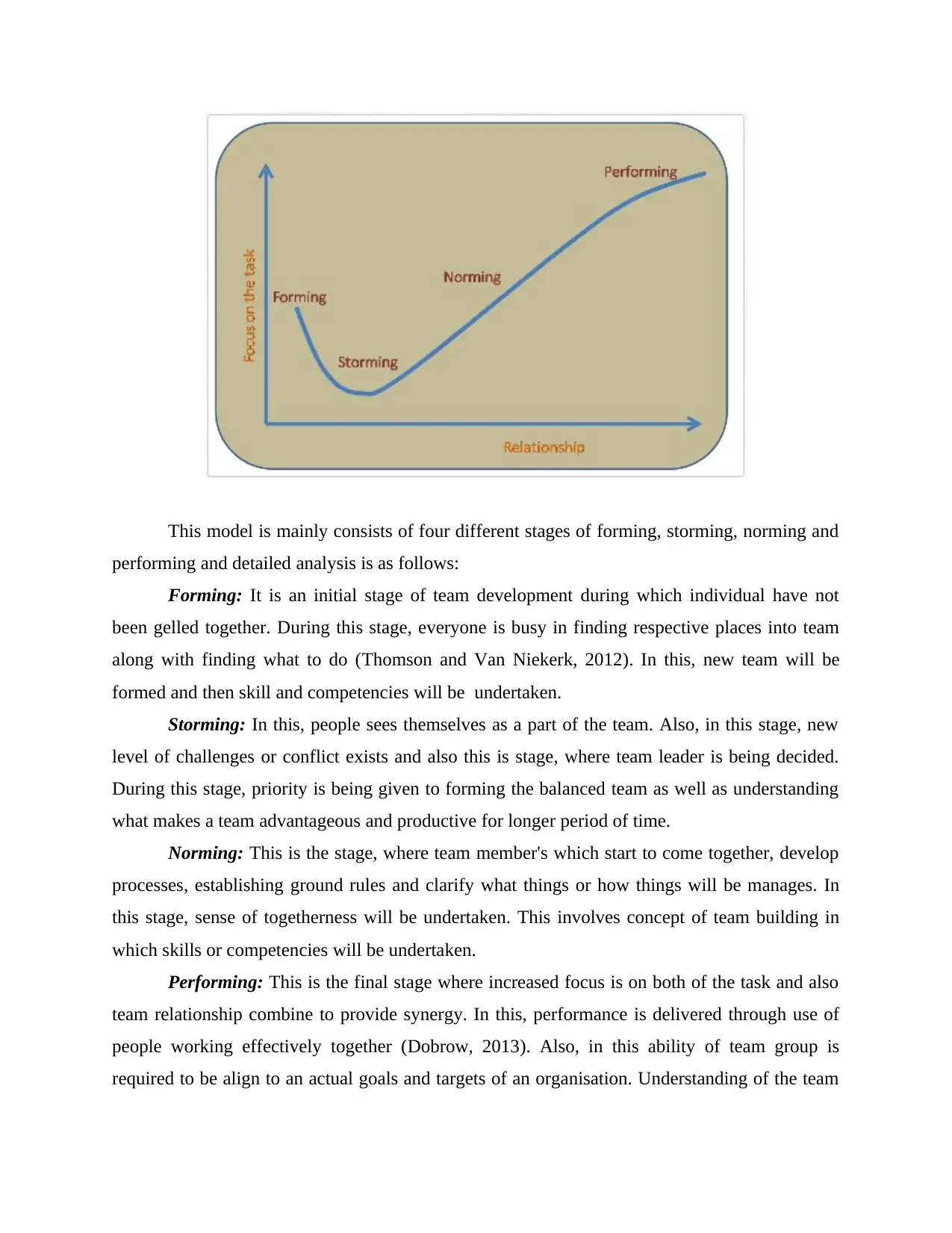
This model is mainly consists of four different stages of forming, storming, norming and
performing and detailed analysis is as follows:
Forming: It is an initial stage of team development during which individual have not
been gelled together. During this stage, everyone is busy in finding respective places into team
along with finding what to do (Thomson and Van Niekerk, 2012). In this, new team will be
formed and then skill and competencies will be undertaken.
Storming: In this, people sees themselves as a part of the team. Also, in this stage, new
level of challenges or conflict exists and also this is stage, where team leader is being decided.
During this stage, priority is being given to forming the balanced team as well as understanding
what makes a team advantageous and productive for longer period of time.
Norming: This is the stage, where team member's which start to come together, develop
processes, establishing ground rules and clarify what things or how things will be manages. In
this stage, sense of togetherness will be undertaken. This involves concept of team building in
which skills or competencies will be undertaken.
Performing: This is the final stage where increased focus is on both of the task and also
team relationship combine to provide synergy. In this, performance is delivered through use of
people working effectively together (Dobrow, 2013). Also, in this ability of team group is
required to be align to an actual goals and targets of an organisation. Understanding of the team
performing and detailed analysis is as follows:
Forming: It is an initial stage of team development during which individual have not
been gelled together. During this stage, everyone is busy in finding respective places into team
along with finding what to do (Thomson and Van Niekerk, 2012). In this, new team will be
formed and then skill and competencies will be undertaken.
Storming: In this, people sees themselves as a part of the team. Also, in this stage, new
level of challenges or conflict exists and also this is stage, where team leader is being decided.
During this stage, priority is being given to forming the balanced team as well as understanding
what makes a team advantageous and productive for longer period of time.
Norming: This is the stage, where team member's which start to come together, develop
processes, establishing ground rules and clarify what things or how things will be manages. In
this stage, sense of togetherness will be undertaken. This involves concept of team building in
which skills or competencies will be undertaken.
Performing: This is the final stage where increased focus is on both of the task and also
team relationship combine to provide synergy. In this, performance is delivered through use of
people working effectively together (Dobrow, 2013). Also, in this ability of team group is
required to be align to an actual goals and targets of an organisation. Understanding of the team
Secure Best Marks with AI Grader
Need help grading? Try our AI Grader for instant feedback on your assignments.
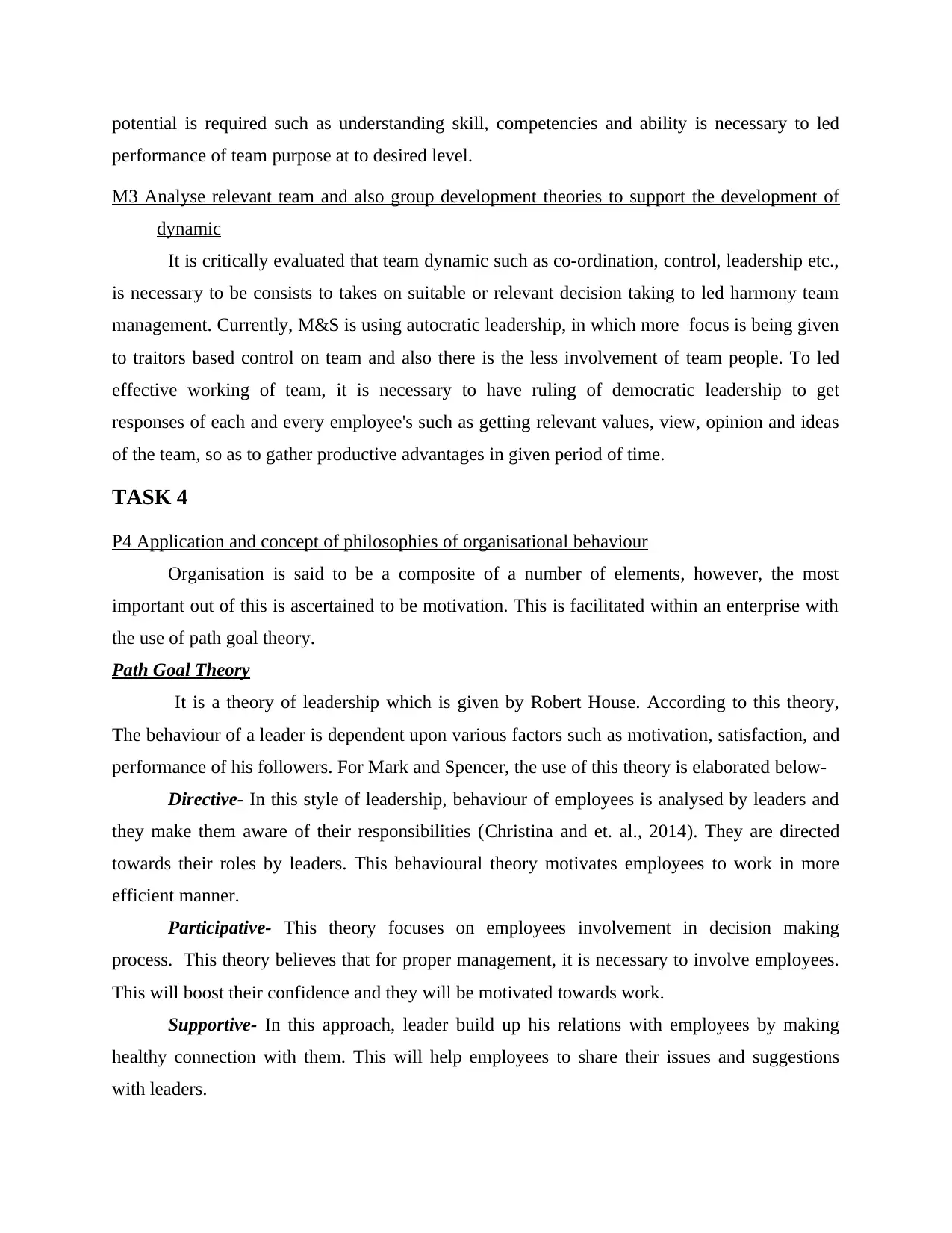
potential is required such as understanding skill, competencies and ability is necessary to led
performance of team purpose at to desired level.
M3 Analyse relevant team and also group development theories to support the development of
dynamic
It is critically evaluated that team dynamic such as co-ordination, control, leadership etc.,
is necessary to be consists to takes on suitable or relevant decision taking to led harmony team
management. Currently, M&S is using autocratic leadership, in which more focus is being given
to traitors based control on team and also there is the less involvement of team people. To led
effective working of team, it is necessary to have ruling of democratic leadership to get
responses of each and every employee's such as getting relevant values, view, opinion and ideas
of the team, so as to gather productive advantages in given period of time.
TASK 4
P4 Application and concept of philosophies of organisational behaviour
Organisation is said to be a composite of a number of elements, however, the most
important out of this is ascertained to be motivation. This is facilitated within an enterprise with
the use of path goal theory.
Path Goal Theory
It is a theory of leadership which is given by Robert House. According to this theory,
The behaviour of a leader is dependent upon various factors such as motivation, satisfaction, and
performance of his followers. For Mark and Spencer, the use of this theory is elaborated below-
Directive- In this style of leadership, behaviour of employees is analysed by leaders and
they make them aware of their responsibilities (Christina and et. al., 2014). They are directed
towards their roles by leaders. This behavioural theory motivates employees to work in more
efficient manner.
Participative- This theory focuses on employees involvement in decision making
process. This theory believes that for proper management, it is necessary to involve employees.
This will boost their confidence and they will be motivated towards work.
Supportive- In this approach, leader build up his relations with employees by making
healthy connection with them. This will help employees to share their issues and suggestions
with leaders.
performance of team purpose at to desired level.
M3 Analyse relevant team and also group development theories to support the development of
dynamic
It is critically evaluated that team dynamic such as co-ordination, control, leadership etc.,
is necessary to be consists to takes on suitable or relevant decision taking to led harmony team
management. Currently, M&S is using autocratic leadership, in which more focus is being given
to traitors based control on team and also there is the less involvement of team people. To led
effective working of team, it is necessary to have ruling of democratic leadership to get
responses of each and every employee's such as getting relevant values, view, opinion and ideas
of the team, so as to gather productive advantages in given period of time.
TASK 4
P4 Application and concept of philosophies of organisational behaviour
Organisation is said to be a composite of a number of elements, however, the most
important out of this is ascertained to be motivation. This is facilitated within an enterprise with
the use of path goal theory.
Path Goal Theory
It is a theory of leadership which is given by Robert House. According to this theory,
The behaviour of a leader is dependent upon various factors such as motivation, satisfaction, and
performance of his followers. For Mark and Spencer, the use of this theory is elaborated below-
Directive- In this style of leadership, behaviour of employees is analysed by leaders and
they make them aware of their responsibilities (Christina and et. al., 2014). They are directed
towards their roles by leaders. This behavioural theory motivates employees to work in more
efficient manner.
Participative- This theory focuses on employees involvement in decision making
process. This theory believes that for proper management, it is necessary to involve employees.
This will boost their confidence and they will be motivated towards work.
Supportive- In this approach, leader build up his relations with employees by making
healthy connection with them. This will help employees to share their issues and suggestions
with leaders.
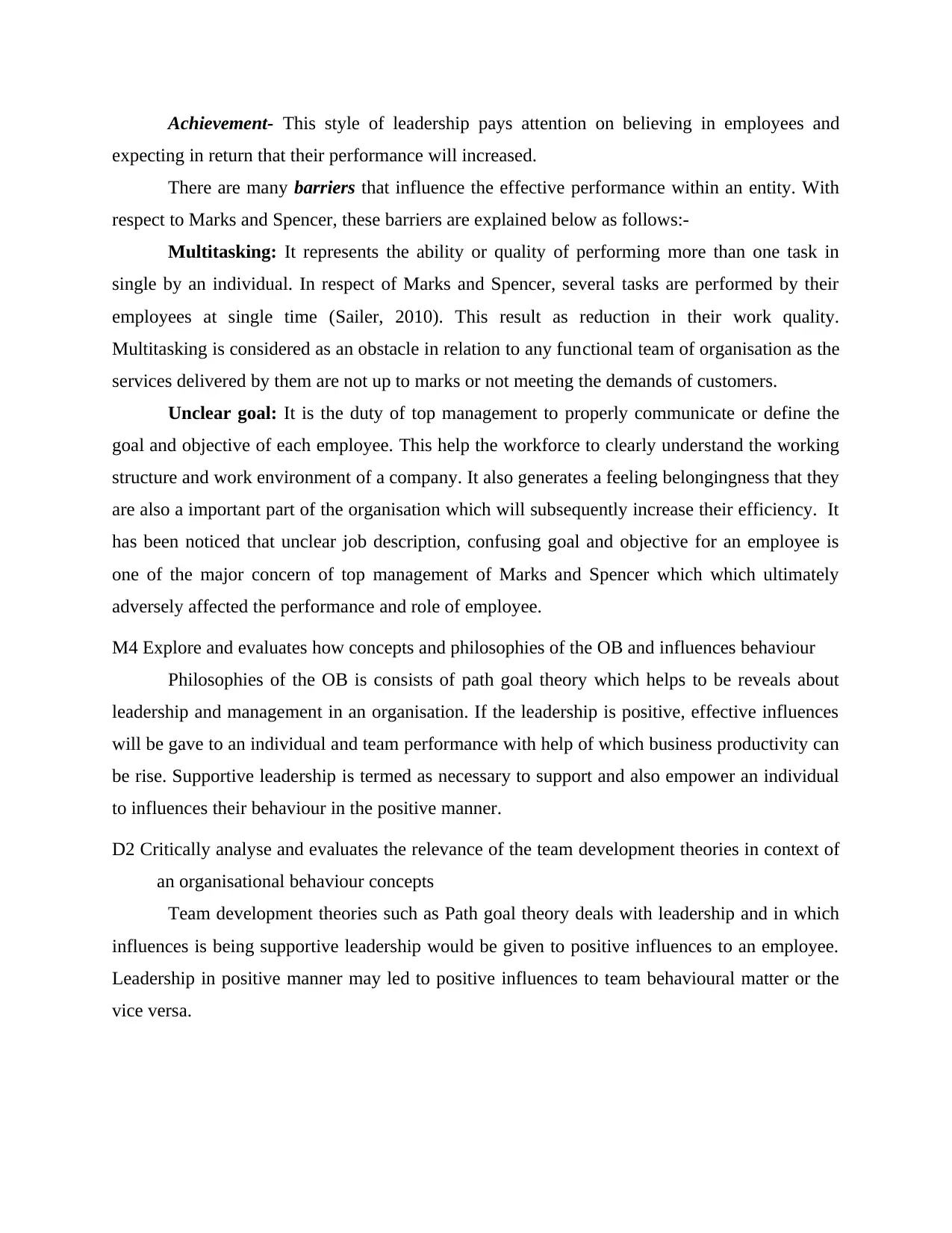
Achievement- This style of leadership pays attention on believing in employees and
expecting in return that their performance will increased.
There are many barriers that influence the effective performance within an entity. With
respect to Marks and Spencer, these barriers are explained below as follows:-
Multitasking: It represents the ability or quality of performing more than one task in
single by an individual. In respect of Marks and Spencer, several tasks are performed by their
employees at single time (Sailer, 2010). This result as reduction in their work quality.
Multitasking is considered as an obstacle in relation to any functional team of organisation as the
services delivered by them are not up to marks or not meeting the demands of customers.
Unclear goal: It is the duty of top management to properly communicate or define the
goal and objective of each employee. This help the workforce to clearly understand the working
structure and work environment of a company. It also generates a feeling belongingness that they
are also a important part of the organisation which will subsequently increase their efficiency. It
has been noticed that unclear job description, confusing goal and objective for an employee is
one of the major concern of top management of Marks and Spencer which which ultimately
adversely affected the performance and role of employee.
M4 Explore and evaluates how concepts and philosophies of the OB and influences behaviour
Philosophies of the OB is consists of path goal theory which helps to be reveals about
leadership and management in an organisation. If the leadership is positive, effective influences
will be gave to an individual and team performance with help of which business productivity can
be rise. Supportive leadership is termed as necessary to support and also empower an individual
to influences their behaviour in the positive manner.
D2 Critically analyse and evaluates the relevance of the team development theories in context of
an organisational behaviour concepts
Team development theories such as Path goal theory deals with leadership and in which
influences is being supportive leadership would be given to positive influences to an employee.
Leadership in positive manner may led to positive influences to team behavioural matter or the
vice versa.
expecting in return that their performance will increased.
There are many barriers that influence the effective performance within an entity. With
respect to Marks and Spencer, these barriers are explained below as follows:-
Multitasking: It represents the ability or quality of performing more than one task in
single by an individual. In respect of Marks and Spencer, several tasks are performed by their
employees at single time (Sailer, 2010). This result as reduction in their work quality.
Multitasking is considered as an obstacle in relation to any functional team of organisation as the
services delivered by them are not up to marks or not meeting the demands of customers.
Unclear goal: It is the duty of top management to properly communicate or define the
goal and objective of each employee. This help the workforce to clearly understand the working
structure and work environment of a company. It also generates a feeling belongingness that they
are also a important part of the organisation which will subsequently increase their efficiency. It
has been noticed that unclear job description, confusing goal and objective for an employee is
one of the major concern of top management of Marks and Spencer which which ultimately
adversely affected the performance and role of employee.
M4 Explore and evaluates how concepts and philosophies of the OB and influences behaviour
Philosophies of the OB is consists of path goal theory which helps to be reveals about
leadership and management in an organisation. If the leadership is positive, effective influences
will be gave to an individual and team performance with help of which business productivity can
be rise. Supportive leadership is termed as necessary to support and also empower an individual
to influences their behaviour in the positive manner.
D2 Critically analyse and evaluates the relevance of the team development theories in context of
an organisational behaviour concepts
Team development theories such as Path goal theory deals with leadership and in which
influences is being supportive leadership would be given to positive influences to an employee.
Leadership in positive manner may led to positive influences to team behavioural matter or the
vice versa.
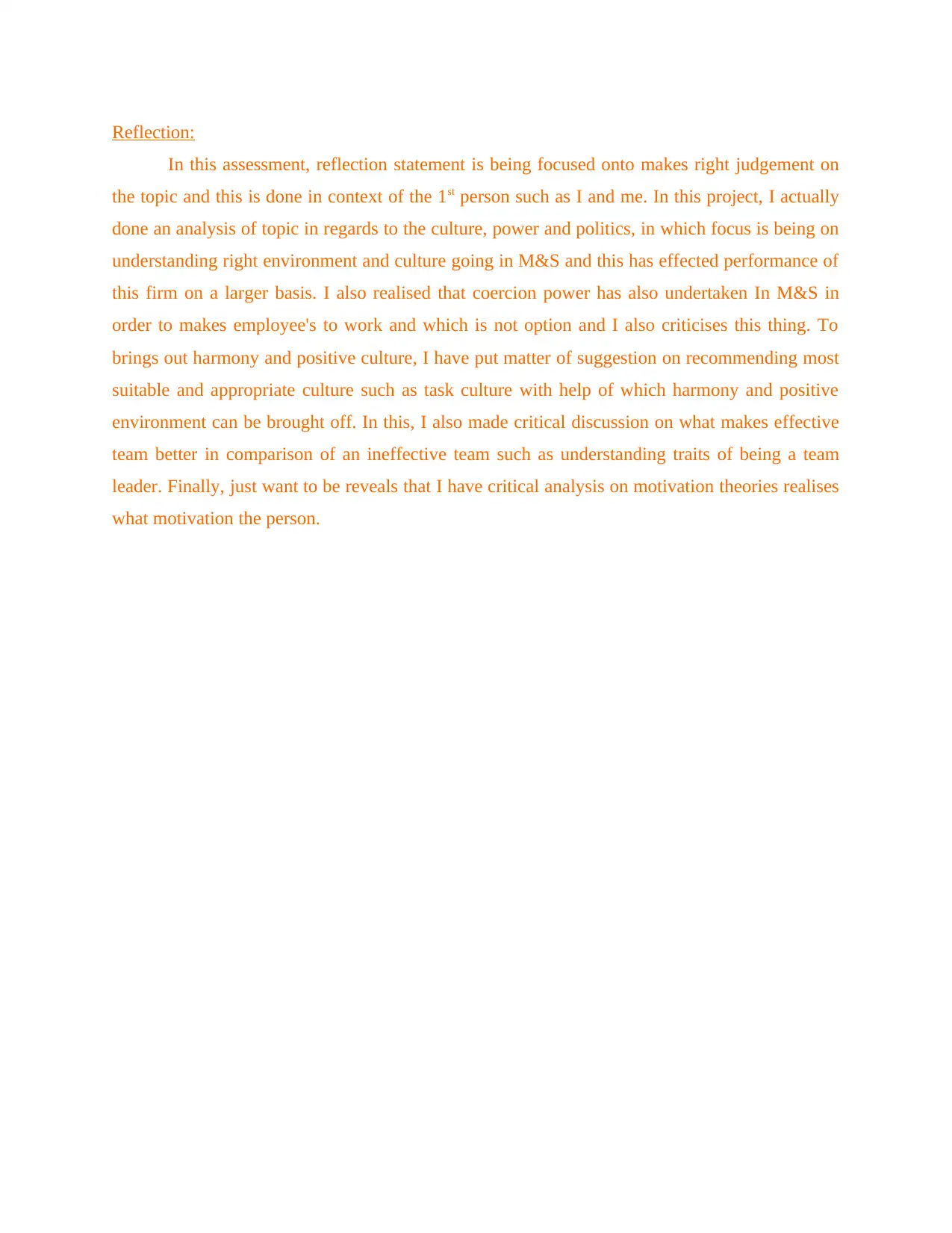
Reflection:
In this assessment, reflection statement is being focused onto makes right judgement on
the topic and this is done in context of the 1st person such as I and me. In this project, I actually
done an analysis of topic in regards to the culture, power and politics, in which focus is being on
understanding right environment and culture going in M&S and this has effected performance of
this firm on a larger basis. I also realised that coercion power has also undertaken In M&S in
order to makes employee's to work and which is not option and I also criticises this thing. To
brings out harmony and positive culture, I have put matter of suggestion on recommending most
suitable and appropriate culture such as task culture with help of which harmony and positive
environment can be brought off. In this, I also made critical discussion on what makes effective
team better in comparison of an ineffective team such as understanding traits of being a team
leader. Finally, just want to be reveals that I have critical analysis on motivation theories realises
what motivation the person.
In this assessment, reflection statement is being focused onto makes right judgement on
the topic and this is done in context of the 1st person such as I and me. In this project, I actually
done an analysis of topic in regards to the culture, power and politics, in which focus is being on
understanding right environment and culture going in M&S and this has effected performance of
this firm on a larger basis. I also realised that coercion power has also undertaken In M&S in
order to makes employee's to work and which is not option and I also criticises this thing. To
brings out harmony and positive culture, I have put matter of suggestion on recommending most
suitable and appropriate culture such as task culture with help of which harmony and positive
environment can be brought off. In this, I also made critical discussion on what makes effective
team better in comparison of an ineffective team such as understanding traits of being a team
leader. Finally, just want to be reveals that I have critical analysis on motivation theories realises
what motivation the person.
Paraphrase This Document
Need a fresh take? Get an instant paraphrase of this document with our AI Paraphraser
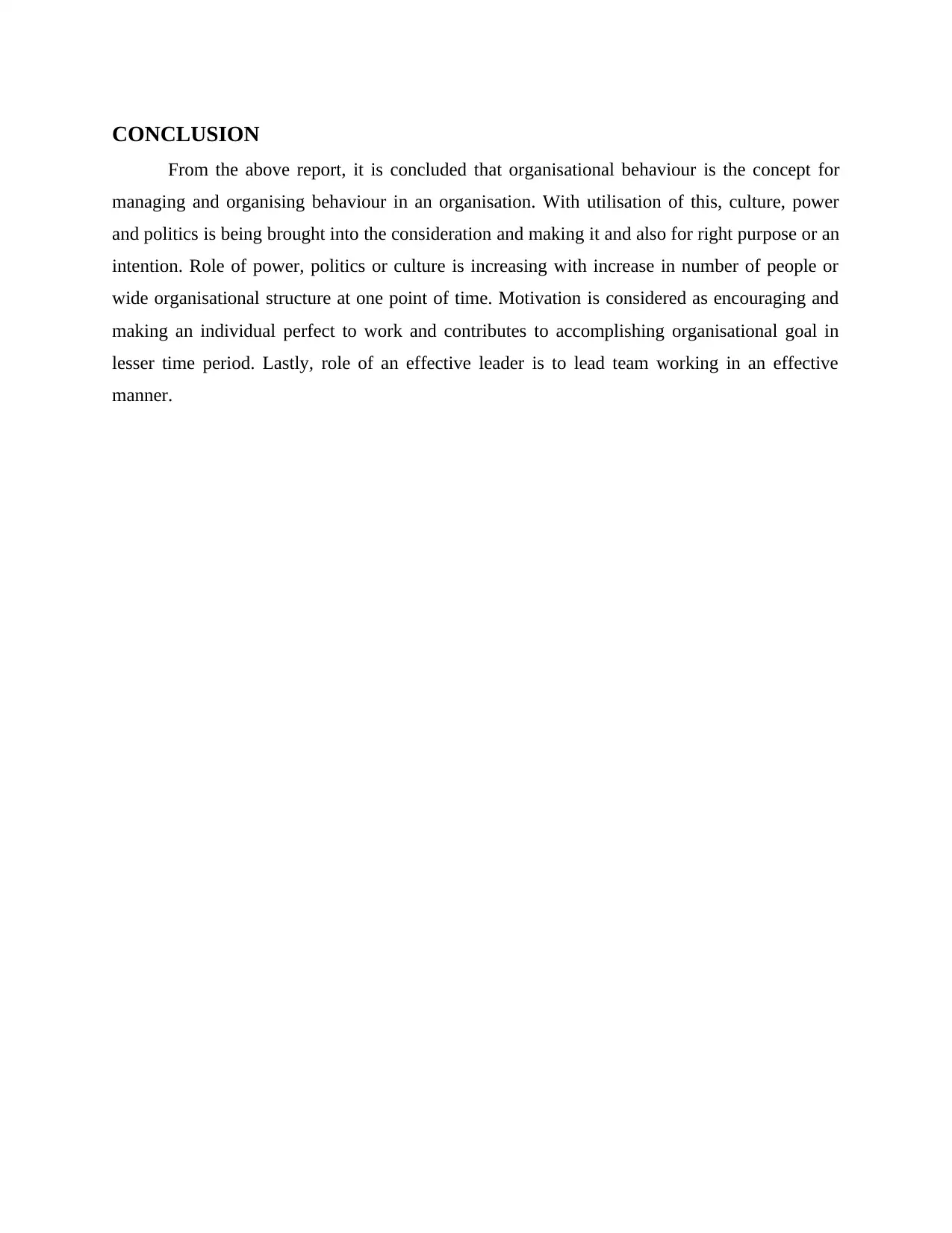
CONCLUSION
From the above report, it is concluded that organisational behaviour is the concept for
managing and organising behaviour in an organisation. With utilisation of this, culture, power
and politics is being brought into the consideration and making it and also for right purpose or an
intention. Role of power, politics or culture is increasing with increase in number of people or
wide organisational structure at one point of time. Motivation is considered as encouraging and
making an individual perfect to work and contributes to accomplishing organisational goal in
lesser time period. Lastly, role of an effective leader is to lead team working in an effective
manner.
From the above report, it is concluded that organisational behaviour is the concept for
managing and organising behaviour in an organisation. With utilisation of this, culture, power
and politics is being brought into the consideration and making it and also for right purpose or an
intention. Role of power, politics or culture is increasing with increase in number of people or
wide organisational structure at one point of time. Motivation is considered as encouraging and
making an individual perfect to work and contributes to accomplishing organisational goal in
lesser time period. Lastly, role of an effective leader is to lead team working in an effective
manner.
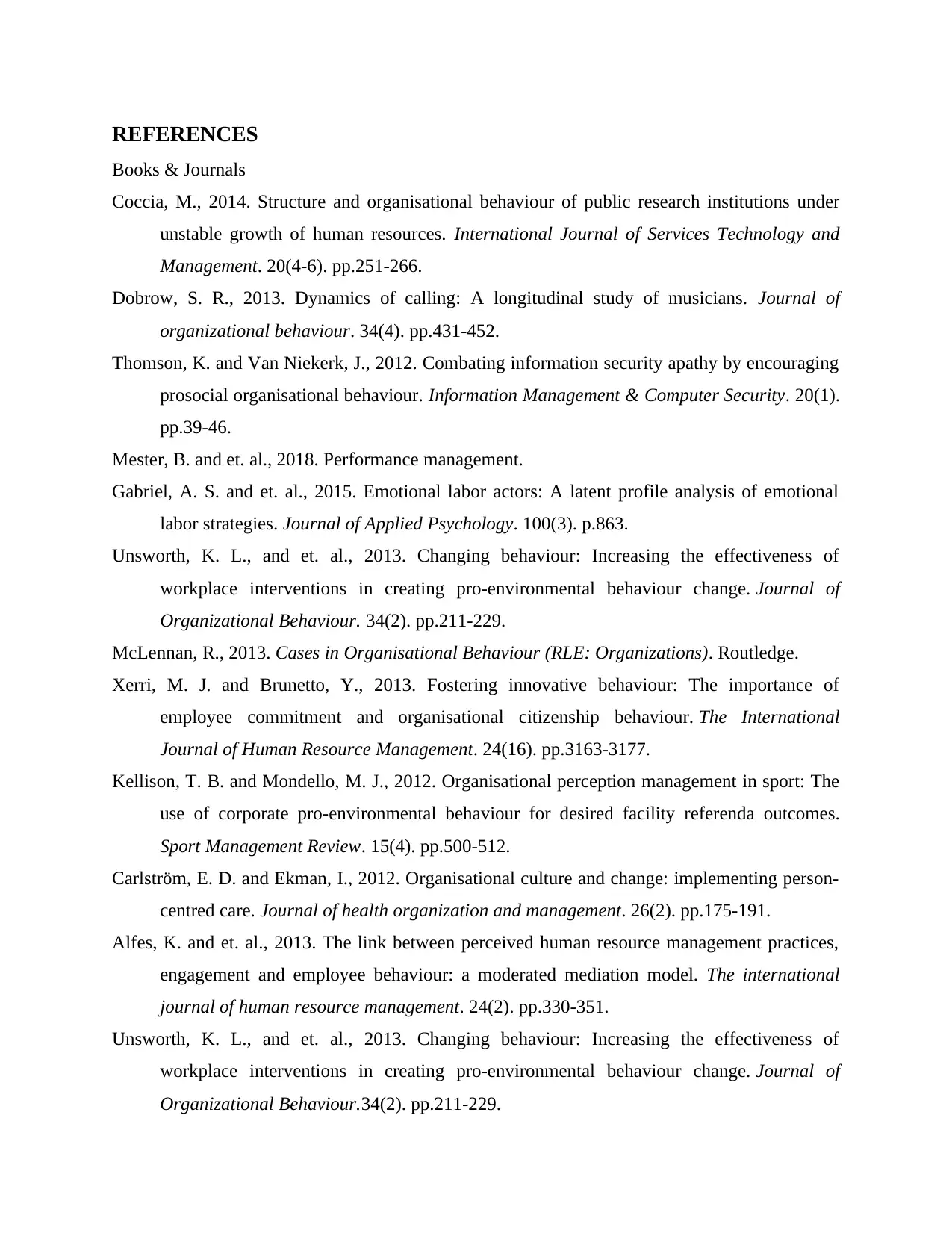
REFERENCES
Books & Journals
Coccia, M., 2014. Structure and organisational behaviour of public research institutions under
unstable growth of human resources. International Journal of Services Technology and
Management. 20(4-6). pp.251-266.
Dobrow, S. R., 2013. Dynamics of calling: A longitudinal study of musicians. Journal of
organizational behaviour. 34(4). pp.431-452.
Thomson, K. and Van Niekerk, J., 2012. Combating information security apathy by encouraging
prosocial organisational behaviour. Information Management & Computer Security. 20(1).
pp.39-46.
Mester, B. and et. al., 2018. Performance management.
Gabriel, A. S. and et. al., 2015. Emotional labor actors: A latent profile analysis of emotional
labor strategies. Journal of Applied Psychology. 100(3). p.863.
Unsworth, K. L., and et. al., 2013. Changing behaviour: Increasing the effectiveness of
workplace interventions in creating pro‐environmental behaviour change. Journal of
Organizational Behaviour. 34(2). pp.211-229.
McLennan, R., 2013. Cases in Organisational Behaviour (RLE: Organizations). Routledge.
Xerri, M. J. and Brunetto, Y., 2013. Fostering innovative behaviour: The importance of
employee commitment and organisational citizenship behaviour. The International
Journal of Human Resource Management. 24(16). pp.3163-3177.
Kellison, T. B. and Mondello, M. J., 2012. Organisational perception management in sport: The
use of corporate pro-environmental behaviour for desired facility referenda outcomes.
Sport Management Review. 15(4). pp.500-512.
Carlström, E. D. and Ekman, I., 2012. Organisational culture and change: implementing person-
centred care. Journal of health organization and management. 26(2). pp.175-191.
Alfes, K. and et. al., 2013. The link between perceived human resource management practices,
engagement and employee behaviour: a moderated mediation model. The international
journal of human resource management. 24(2). pp.330-351.
Unsworth, K. L., and et. al., 2013. Changing behaviour: Increasing the effectiveness of
workplace interventions in creating pro‐environmental behaviour change. Journal of
Organizational Behaviour.34(2). pp.211-229.
Books & Journals
Coccia, M., 2014. Structure and organisational behaviour of public research institutions under
unstable growth of human resources. International Journal of Services Technology and
Management. 20(4-6). pp.251-266.
Dobrow, S. R., 2013. Dynamics of calling: A longitudinal study of musicians. Journal of
organizational behaviour. 34(4). pp.431-452.
Thomson, K. and Van Niekerk, J., 2012. Combating information security apathy by encouraging
prosocial organisational behaviour. Information Management & Computer Security. 20(1).
pp.39-46.
Mester, B. and et. al., 2018. Performance management.
Gabriel, A. S. and et. al., 2015. Emotional labor actors: A latent profile analysis of emotional
labor strategies. Journal of Applied Psychology. 100(3). p.863.
Unsworth, K. L., and et. al., 2013. Changing behaviour: Increasing the effectiveness of
workplace interventions in creating pro‐environmental behaviour change. Journal of
Organizational Behaviour. 34(2). pp.211-229.
McLennan, R., 2013. Cases in Organisational Behaviour (RLE: Organizations). Routledge.
Xerri, M. J. and Brunetto, Y., 2013. Fostering innovative behaviour: The importance of
employee commitment and organisational citizenship behaviour. The International
Journal of Human Resource Management. 24(16). pp.3163-3177.
Kellison, T. B. and Mondello, M. J., 2012. Organisational perception management in sport: The
use of corporate pro-environmental behaviour for desired facility referenda outcomes.
Sport Management Review. 15(4). pp.500-512.
Carlström, E. D. and Ekman, I., 2012. Organisational culture and change: implementing person-
centred care. Journal of health organization and management. 26(2). pp.175-191.
Alfes, K. and et. al., 2013. The link between perceived human resource management practices,
engagement and employee behaviour: a moderated mediation model. The international
journal of human resource management. 24(2). pp.330-351.
Unsworth, K. L., and et. al., 2013. Changing behaviour: Increasing the effectiveness of
workplace interventions in creating pro‐environmental behaviour change. Journal of
Organizational Behaviour.34(2). pp.211-229.
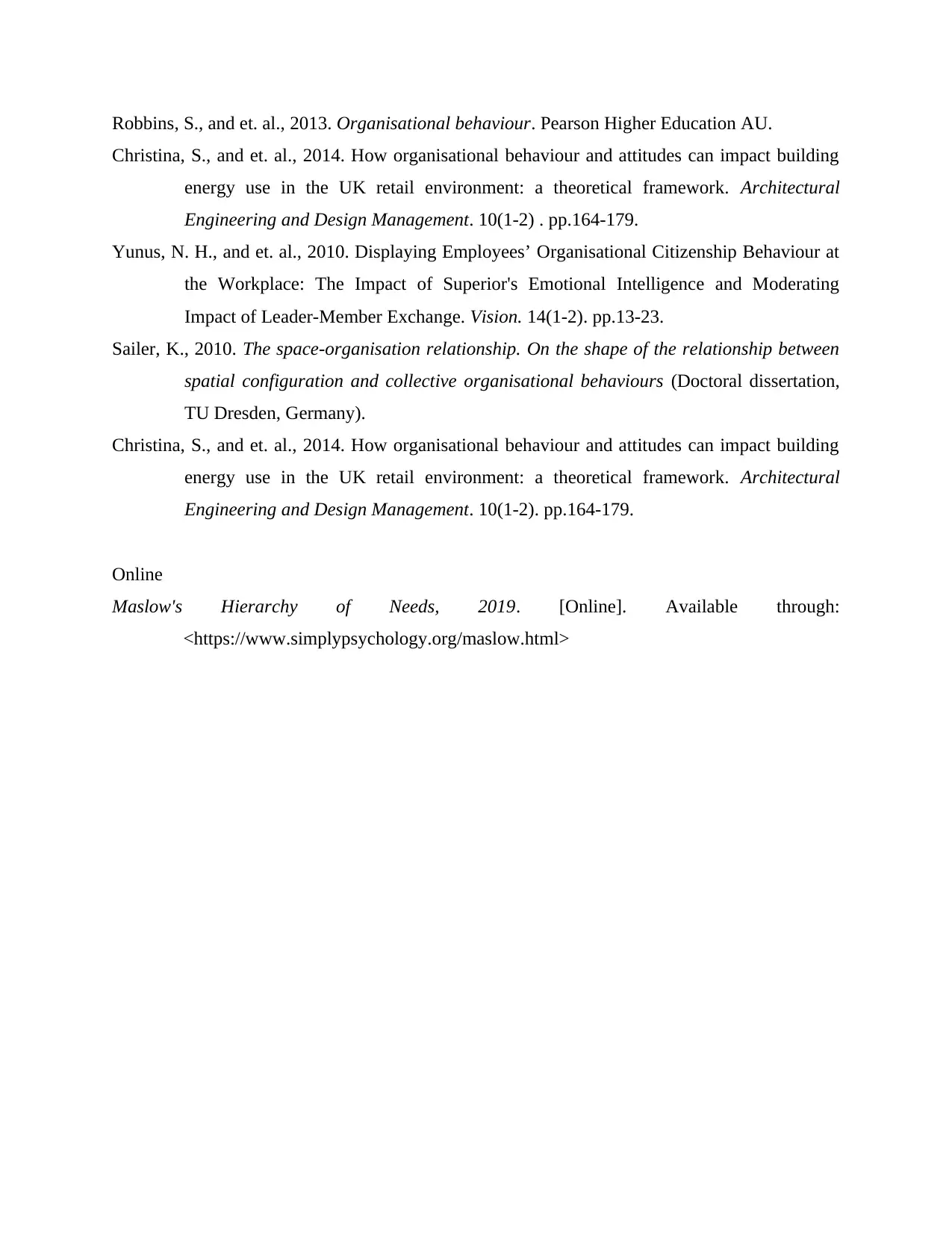
Robbins, S., and et. al., 2013. Organisational behaviour. Pearson Higher Education AU.
Christina, S., and et. al., 2014. How organisational behaviour and attitudes can impact building
energy use in the UK retail environment: a theoretical framework. Architectural
Engineering and Design Management. 10(1-2) . pp.164-179.
Yunus, N. H., and et. al., 2010. Displaying Employees’ Organisational Citizenship Behaviour at
the Workplace: The Impact of Superior's Emotional Intelligence and Moderating
Impact of Leader-Member Exchange. Vision. 14(1-2). pp.13-23.
Sailer, K., 2010. The space-organisation relationship. On the shape of the relationship between
spatial configuration and collective organisational behaviours (Doctoral dissertation,
TU Dresden, Germany).
Christina, S., and et. al., 2014. How organisational behaviour and attitudes can impact building
energy use in the UK retail environment: a theoretical framework. Architectural
Engineering and Design Management. 10(1-2). pp.164-179.
Online
Maslow's Hierarchy of Needs, 2019. [Online]. Available through:
<https://www.simplypsychology.org/maslow.html>
Christina, S., and et. al., 2014. How organisational behaviour and attitudes can impact building
energy use in the UK retail environment: a theoretical framework. Architectural
Engineering and Design Management. 10(1-2) . pp.164-179.
Yunus, N. H., and et. al., 2010. Displaying Employees’ Organisational Citizenship Behaviour at
the Workplace: The Impact of Superior's Emotional Intelligence and Moderating
Impact of Leader-Member Exchange. Vision. 14(1-2). pp.13-23.
Sailer, K., 2010. The space-organisation relationship. On the shape of the relationship between
spatial configuration and collective organisational behaviours (Doctoral dissertation,
TU Dresden, Germany).
Christina, S., and et. al., 2014. How organisational behaviour and attitudes can impact building
energy use in the UK retail environment: a theoretical framework. Architectural
Engineering and Design Management. 10(1-2). pp.164-179.
Online
Maslow's Hierarchy of Needs, 2019. [Online]. Available through:
<https://www.simplypsychology.org/maslow.html>
1 out of 16
Related Documents
Your All-in-One AI-Powered Toolkit for Academic Success.
+13062052269
info@desklib.com
Available 24*7 on WhatsApp / Email
![[object Object]](/_next/static/media/star-bottom.7253800d.svg)
Unlock your academic potential
© 2024 | Zucol Services PVT LTD | All rights reserved.




